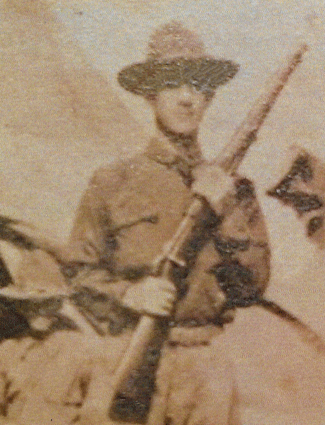
134th Infantry Regiment Website
"All Hell Can't Stop Us"

 |
134th Infantry Regiment Website"All Hell Can't Stop Us" |
 |


Second Lieutenant John H. Fling, a member of Company I, 138th Infantry, 35th Division, received the Distinguished Service Cross for his leadership under fire and while wounded during the battle of Cheppy, France on September 26 - 27, 1918. At the time the unit First Sergeant, he took command on the death of his company commander, withdrew and reorganized the unit, and continued the advance over a gassed area, while he himself could not wear a mask because of his wounds. Commissioned a Second Lieutenant after the war, he also received the French Croix De Guerre, the Purple Heart, and the World War I Victory Medal for his actions in the Meuse - Argonne, St. Mihiel, and Defensive Sector.
Born on November 4, 1892 in St. Paul, Minnesota, Fling spent his childhood there. The family then moved to St. Joseph, Missouri. Fling joined the Missouri National Guard in the spring of 1917 at the age of 25. He was a graduate of Christian Brothers College in St. Joseph, Missouri and, prior to enlisting in the National Guard, was the office manager for the Parker Gordon Cigar Store in St. Louis, Missouri. This was prior to the United States entry into World War I.
The Missouri and Kansas National Guard brigades were inducted into Federal Service on August 5, 1917, and at Camp Doniphan, Oklahoma, were formed into the core of the 35th Infantry Division. At the time of induction, Fling was a Corporal in Company I, Second Missouri Infantry Brigade, Fifth Regiment. He and his unit, organized into Company I, 138th Infantry, trained at Camp Doniphan, Oklahoma until the middle of April 1918, when it was sent to France. They arrived at LeHavre, France on May 11, 1918 and training continued until July 1, when the 35th Division was sent to the Vosges Mountain sector and held in reserve.
Fling and the 35th Infantry Division first saw combat in the Meuse - Argonne Offensive, launched at 5:30 a.m. on September 26, 1918. The 35th Division drove north against the German Hindenburg Line, flanked by the 91st Division on its right and the 28th Division on its left. The 138th and 137th Infantry Regiments were the main attack force for the 35th Infantry Division and was supported by the 344th Tank Battalion under the command of Colonel George S. Patton.
During the early stages of the battle, the Division fought through heavy fog, machine gun fire, and an artillery barrage. In spite of these obstacles the 138th, with support from six tanks, captured Cheppy, France by 1 p.m. The 138th Regiment suffered heavy casualties capturing Cheppy, including many of its officers. John Fling's Company I lost all of its officers, leaving him, at the Company First Sergeant, in charge of the unit. He moved Company I out of heavy machine gun fire, regrouped it, and continued the attack. On September 27 he suffered a head wound but remained with the Company, which pressed forward over gassed terrain. Fling was unable to wear a gas mask because of his wounds. His leadership under fire and while wounded led to the award of the Distinguished Service Cross on March 28, 1925. The citation reads:
"Distinguished Service Cross - Cheppy, France, September 26 - 27, 1918. When his company commander was killed and his company left without officers, Sergeant Fling took command of his company, successfully withdrew it from the midst of machine gun nests, reorganized it, and continued the advance. He was severely wounded in the head the next day, but insisted on remaining on duty with his Company and advancing the attack, not withstanding the fact that the advance was over gassed area and his wounds prevented him from wearing a gas mask."
After the war, First Sergeant Fling completed his studies at the Infantry Officer Candidate School in France in January, 1919, making him eligible for appointment to Second Lieutenant of Infantry. He was promoted to Second Lieutenant on February 1, 1919. The 138th Infantry returned to its home station of St. Louis, Missouri in April 1919 and demobilized on May 30, 1919.
In addition to his Distinguished Service Cross, Fling was awarded the French Croix De Guerre (Cross of War) on January 13, 1925, the Purple Heart, and the World War I Victory Medal with bars for action at Meuse - Argonne, St. Mihiel, and the Defensive Sector.
Lieutenant Fling was honorably discharged on May 6, 1919. His discharge certificate described him with brown hair and eyes, fair skin, and five feet, eight inches tall. He was given a bonus of $60.00 with his discharge from the U. S. Army. He returned to St. Louis, Missouri where he later married his wife Eula and they settled in Kansas City, Missouri. Together they raised two daughters - Carolyn Fling Fries and Mary Jane Fling McKim.
He was active in his local American Legion post for many years and assisted in organizing the Alexander Skinker American Legion Post in St. Louis to honor his commander who was killed during the six-day battle in the Argonne. Skinker is also in the 35th Division Hall of Fame. He had a career in sales and co-owned the Central Sales Company and Brookfield Music Company, a company selling records for jukeboxes.
He passed away on November 5, 1972 at the age of 80. Today, he has six grandchildren, eight great grandchildren, and a growing number of great great grandchildren. John Fling's graddaughter, Ginny Lyon (daughter of Carolyn Fling Fries) and her husband Charles Lyon proudly display his awards in their home in Lenexa, Kansas.
2nd Lieutenant John H Fling was inducted into the 35th Division Hall of Fame (Class XIII) on October 9, 2021.